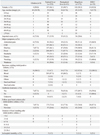1. Lynch M, Painter J, Woodruff R, Braden C. Centers for Disease Control and Prevention. Surveillance for foodborne-disease outbreaks--United States, 1998-2002. MMWR Surveill Summ. 2006; 55:1–42.
2. Lee JH, Lee JH, Kim MS, Park SG. Analysis of foodborne disease outbreaks for improvement of food safety programs in Seoul, Republic of Korea, from 2002 to 2006. J Environ Health. 2009; 71:51–55.
3. Wikswo ME, Hall AJ. Centers for Disease Control and Prevention. Outbreaks of acute gastroenteritis transmitted by person-to-person contact--United States, 2009-2010. MMWR Surveill Summ. 2012; 61:1–12.
4. Guerrant RL, Van Gilder T, Steiner TS, Thielman NM, Slutsker L, Tauxe RV, et al. Practice guidelines for the management of infectious diarrhea. Clin Infect Dis. 2001; 32:331–351.

5. Korea Centers for Disease Control and Prevention. Guidelines for control of infectious diseases. 2011. assessed on 2013 January 26. Available at:
http://www.cdc.go.kr.
6. Heymann DL. American Public Health Association. Control of communicable diseases manual. 19th ed. Washington, DC: American Public Health Association;2008.
7. PHLS Advisory Committee on Gastrointestinal Infections. Preventing person-to-person spread following gastrointestinal infections: guidelines for public health physicians and environmental health officers. Commun Dis Public Health. 2004; 7:362–384.
8. Korea Centers for Disease Control and Prevention. Web statistics of infectious diseases in Korea. assessed on 2013 January 26. Available at:
http://stat.cdc.go.kr/.
9. Wallace CK, Anderson PN, Brown TC, Khanra SR, Lewis GW, Pierce NF, et al. Optimal antibiotic therapy in cholera. Bull World Health Organ. 1968; 39:239–245.
10. Morris JG Jr, Ferreccio C, Garcia J, Lobos H, Black RE, Rodriguez H, et al. Typhoid fever in Santiago, Chile: a study of household contacts of pediatric patients. Am J Trop Med Hyg. 1984; 33:1198–1202.

11. Braddick MR, Crump BJ, Yee ML. How long should patients with Salmonella typhi or Salmonella paratyphi be followed-up? A comparison of published guidelines. J Public Health Med. 1991; 13:101–107.
12. Thomas HL, Addiman S, Mellanby A. Evaluation of the effectiveness and efficiency of the public health management of cases of infection due to Salmonella typhi/paratyphi in North East London. Public Health. 2006; 120:1188–1193.

13. DuPont HL, Hornick RB, Dawkins AT, Snyder MJ, Formal SB. The response of man to virulent Shigella flexneri 2a. J Infect Dis. 1969; 119:296–299.

14. Arias C, Sala MR, Domínguez A, Bartolomé R, Benavente A, Veciana P, et al. Waterborne epidemic outbreak of Shigella sonnei gastroenteritis in Santa Maria de Palautordera, Catalonia, Spain. Epidemiol Infect. 2006; 134:598–604.

15. Shah S, Hoffman R, Shillam P, Wilson B. Prolonged fecal shedding of Escherichia coli O157:H7 during an outbreak at a day care center. Clin Infect Dis. 1996; 23:835–836.

16. Belongia EA, Osterholm MT, Soler JT, Ammend DA, Braun JE, MacDonald KL. Transmission of Escherichia coli O157:H7 infection in Minnesota child day-care facilities. JAMA. 1993; 269:883–888.

17. Lee MS, Kim ES, Kim HB, Hong JY, Lee JY. Opinions of infectious disease specialists on the current method for isolation of group 1 nationally notifiable infectious diseases in Korea. Infect Chemother. 2012; 44:185–187.

18. Korea Centers for Disease Control and Prevention. Guidelines for control of infectious diseases. 2012. assessed on 2013 January 26. Available at:
http://www.cdc.go.kr.
19. Seo JY, Seo JH, Kim MH, Ki M, Park HS, Choi BY. Pattern of hepatitis a incidence according to area characteristics using national health insurance data. J Prev Med Public Health. 2012; 45:164–173.








 PDF
PDF ePub
ePub Citation
Citation Print
Print



 XML Download
XML Download